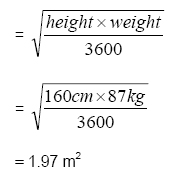For each question, choose the answer you think is correct. Answers are provided at the end of the page.
P.N. is a 76-year-old female diagnosed with adenocarcinoma of the colon, which is now metastatic to the liver. The oncologist has determined that infusional fluorouracil is not suitable for this patient. First line treatment for her advanced disease will be given with GIAVCAP.
Weight: 87 kg Height: 160 cm
Lab results taken 24 hours prior to first treatment:
- WBC 8.4
- ANC 4.4
- Hgb 105
- Platelets 318
- Bilirubin 7
- LDH 225
- AST 75
- Alk Phos 263
- Creatinine 111
- The dose should be 1970 mg PO BID × 14 days, ordered as 2000 mg PO BID × 14 days
- The dose should be 2463 mg PO BID × 14 days, ordered as 2450 mg PO BID × 14 days
- The dose should be 1847 mg PO BID × 14 days, ordered as 2000 mg PO BID × 14 days
- The dose should be 1478 mg PO BID × 14 days, ordered as 1500 mg PO BID × 14 days
- LFTs are within normal limits, and P.N. can receive the dose as prescribed
- LFTs are elevated due to liver metastases, and the dose should be reduced by 75%, as capecitabine is extensively metabolized by the liver
- LFTs are elevated, which is a common occurrence with liver metastases, and capecitabine should be discontinued
- LFTs are elevated due to liver metastases, but P.N. can receive the dose as prescribed
After the fourth cycle of capecitabine, P.N. develops peeling, redness, and pain on both of her hands. She is diagnosed with Grade 3 Palmar-Plantar Erythromatosus (PPE), also known as hand-foot syndrome. Her oncologist decides to delay subsequent capecitabine doses until her pain resolves, and also reduce the capecitabine dose for the next cycle. Thirty days following the fourth cycle, her PPE symptoms have resolved and the oncologist prescribes capecitabine 1477 mg PO daily × 14 days.
Lab results 24 hours prior to treatment:
- WBC 6.7
- ANC 2.4
- Platelets 318
- The interval is correct, but the dose should be 1500 mg PO BID × 14 days
- The interval is too long, and the dose should be 1500 mg PO daily × 14 days
- The interval is too long, and the dose should be 975 mg PO daily × 14 days
- The interval is correct, but the dose should be 975 mg PO BID × 14 days
The correct answer is 1.
Rationale:
BSA calculation

Creatinine Clearance =
N x (140-age) x weight (kg)
Serum creatinine (micromole/L) Where N = 1.04 for females
= 1.04 x (140-76) x 87
111
= 52.2 mL/min
According to the GIAVCAP protocol, the lower dose of 1000 mg/m2 is used because the patient is both elderly and pre-treated. Since creatinine clearance is greater than 50 mL/min, further dose reduction is not required.
1000 mg/m2 x 1.97 m2 = 1970 mg BID x 14 days
As only 150 mg and 500 mg tablets of capecitabine exist, the oncologist should order 2000 mg PO BID x 14 days, and 4 x 500 mg tablets would be dispensed to make up each individual dose.
The correct answer is 4.
Rationale:
Although ranges for liver function tests can vary from lab to lab, P.N.'s LDH, AST and Alk Phos values are definitely considered elevated. This may be attributed to her liver metastases, which can result in elevated liver function tests.
Since capecitabine is not primarily handled by the liver, no dose reductions are required and P.N. can receive the drug as ordered.
The correct answer is 1.
Rationale:
Based on the GIAVCAP protocol "Dose Modifications: 2. Hand-Foot Skin Reaction" section, the interval since the last treatment is correct as treatment should be stopped and delayed until the reaction has resolved to a grade 0-1 level.
The dose should be reduced to 75% of initial dose for Grade 3 hand-foot skin reaction. Since P.N. received 2000 mg, a 75% reduction would bring this to 1500 mg.

